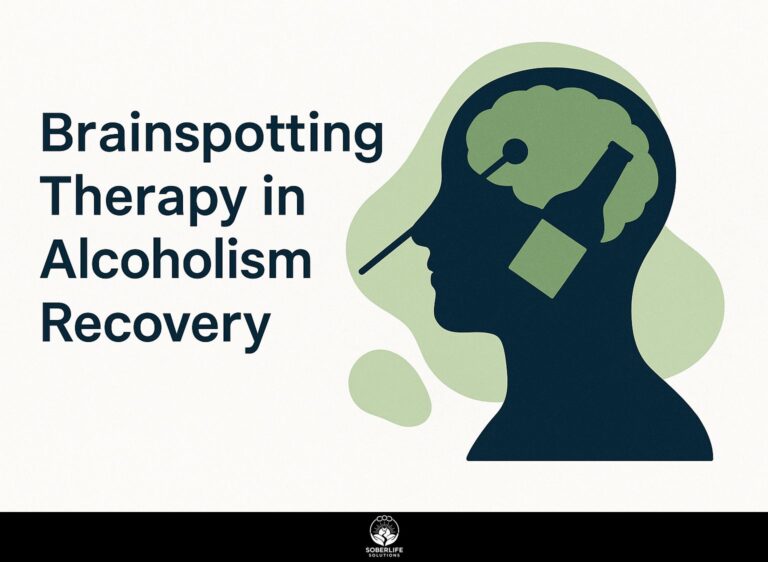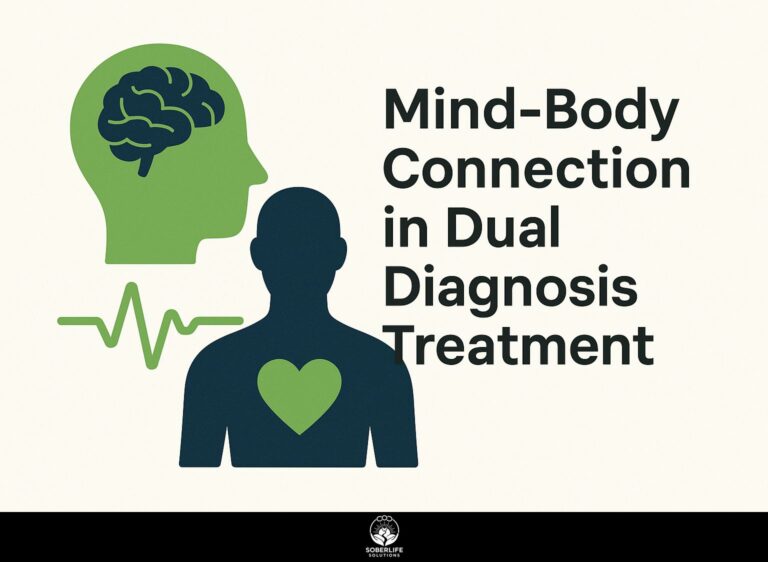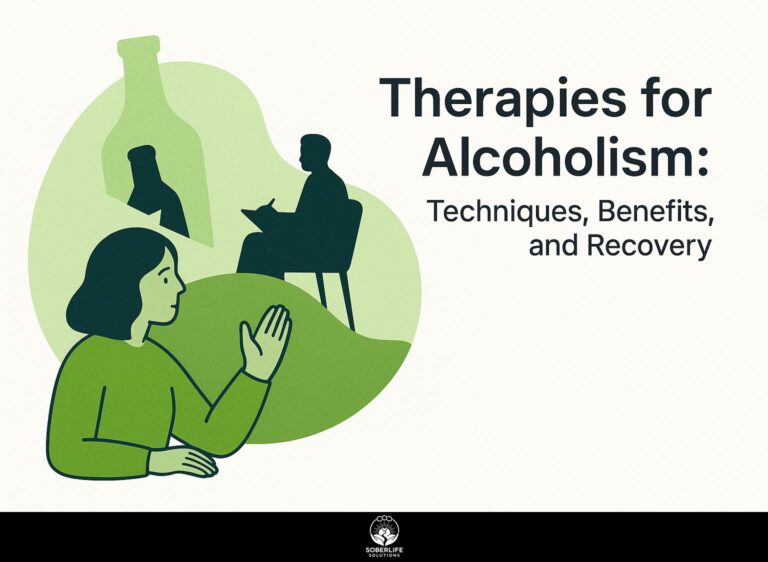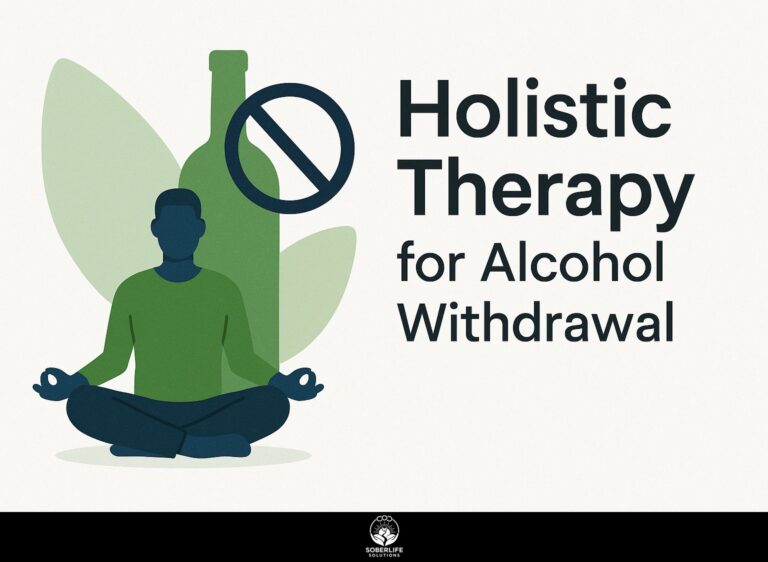Complementary vs Alternative Medicine in Recovery
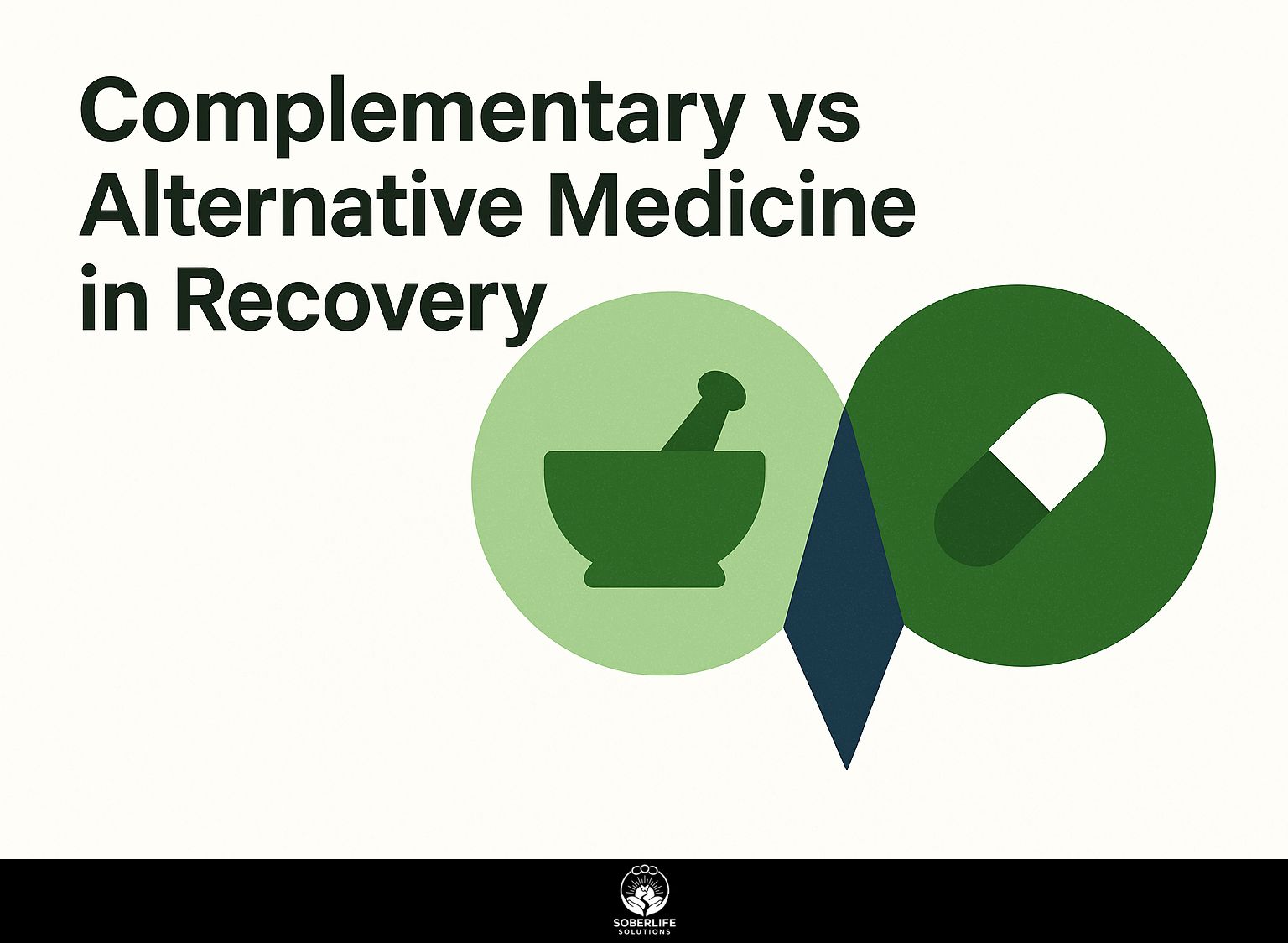
Introduction to CAM in Recovery Recovery can be difficult. Combining complementary medicine with standard medicine can improve results. Alternative medicine can serve as an independent option. CAM includes traditional systems such as TCM and Ayurveda, which stem from traditional medicine’s approach to treating the whole person. Find out the key differences, evidence from studies such as those in the Journal of Alternative and Complementary Medicine, and actual benefits for your recovery. This helps build practical, balanced recovery plans.
Key Takeaways:
Defining Complementary Medicine
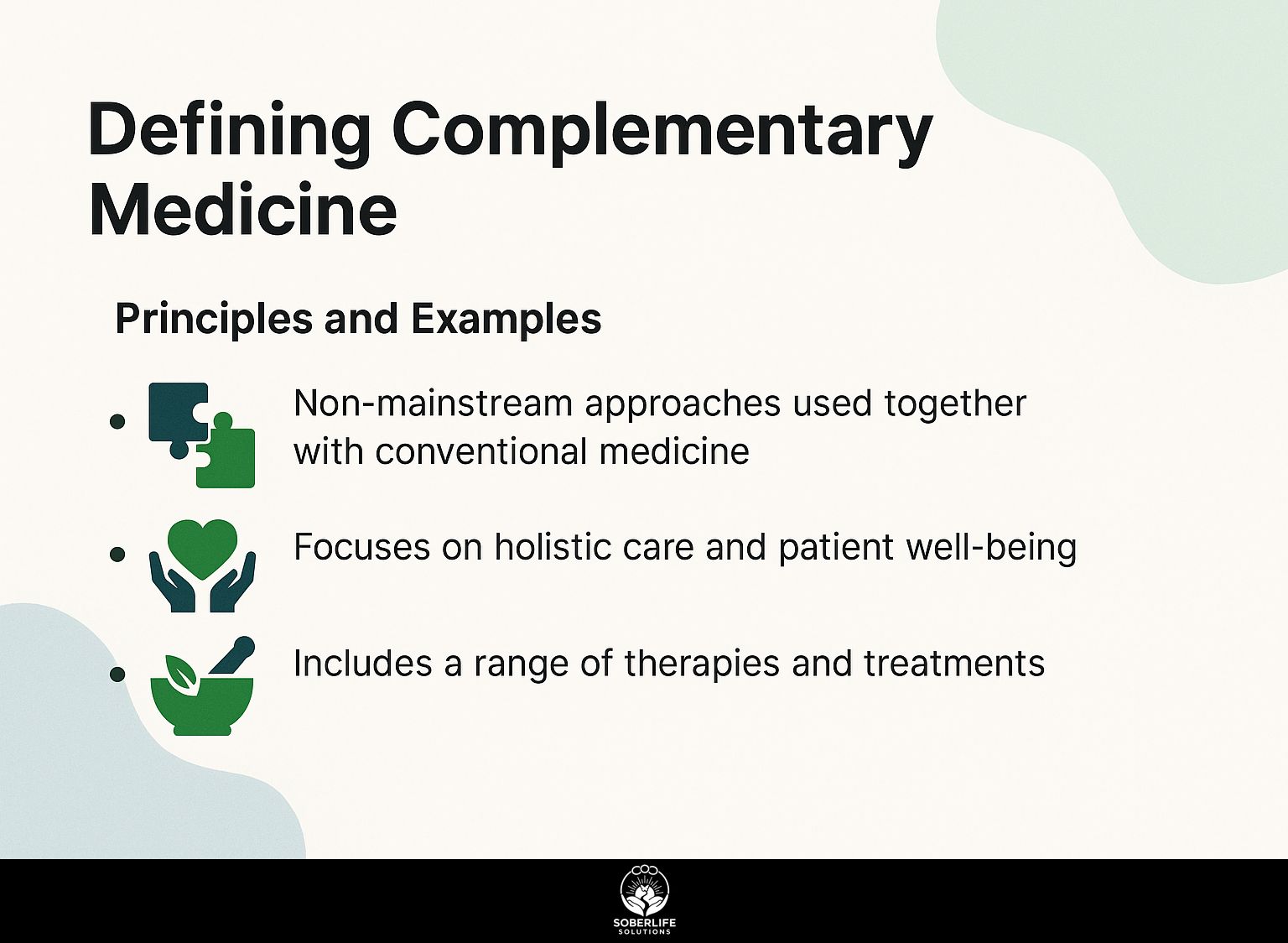
Complementary medicine enhances conventional medicine by adding therapies like acupuncture to standard treatments, forming integrative approaches that 62% of hospitals in the USA now offer per the American Hospital Association. Related insight: Mindfulness-Based Interventions for AUD: Implications
Principles and Examples
Core principles of complementary medicine include using mind-body therapies like yoga to support physical recovery, with studies showing yoga reduces post-surgery pain by 25% in integrative programs.
Key principles build on this foundation:
- Adjunctive support: Pair acupuncture with pain medications; a Mayo Clinic trial found this combo speeds recovery by 30% for chronic back pain.
- Patient-centered care Use meditation apps like Headspace for 10-minute sessions each day to handle stress. Pick ones that fit each person’s needs.
- Holistic balance: Use herbal remedies like ginger tea to alleviate chemotherapy-induced nausea, as supported by NCCIH studies.
- Evidence integration Always follow NCCAM (now NCCIH) guidelines for safe, research-supported supplementary treatments.
To consult providers safely:
- Discuss all therapies with your doctor upfront.
- Review potential interactions via tools like Drugs.com.
- Start low-dose under supervision. Avoid the common mistake of self-dosing herbs, which risks adverse effects.
Defining Alternative Medicine
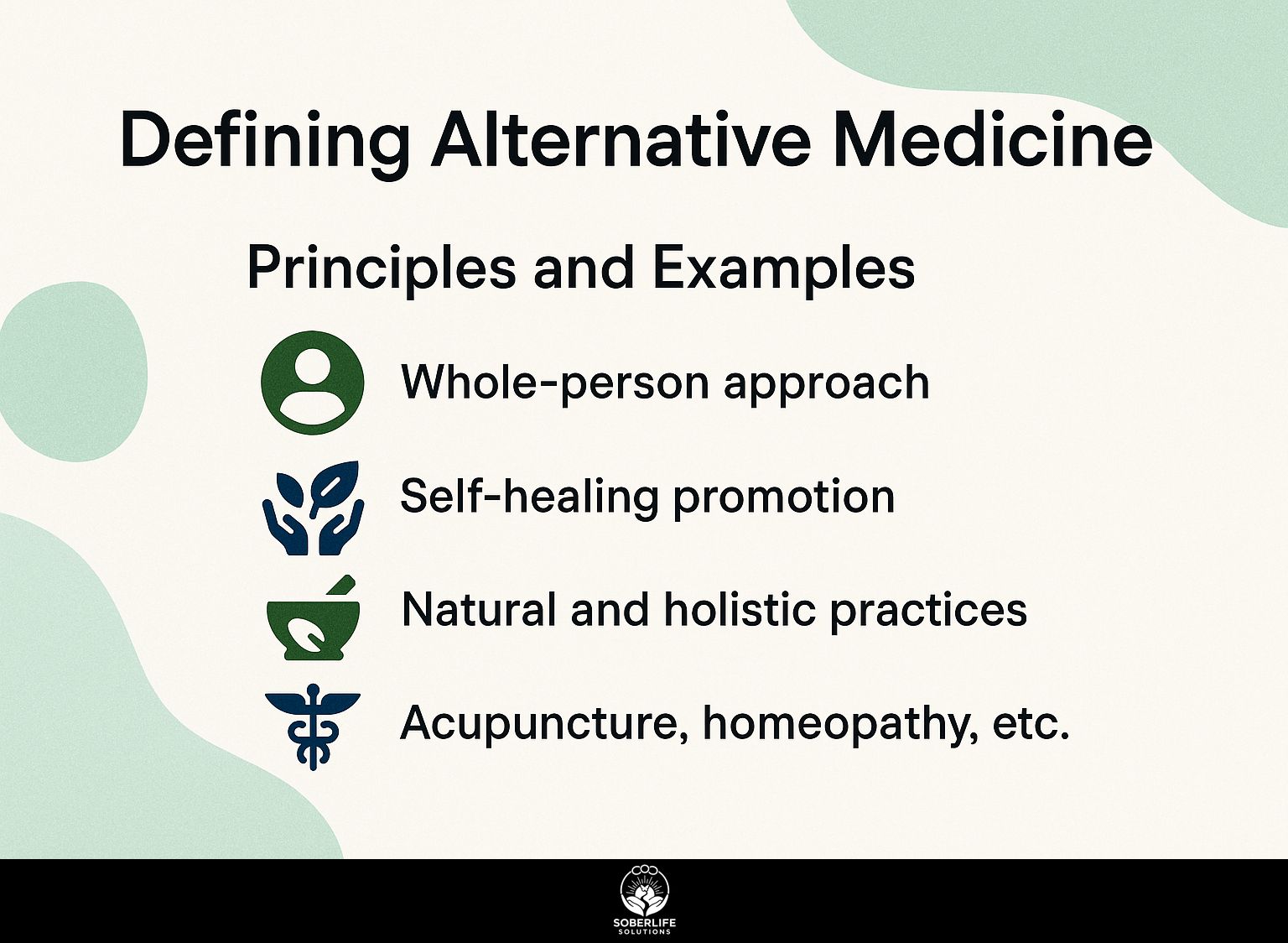
Alternative medicine stands alone as a complete system, like Traditional Chinese Medicine (TCM), where News-Medical.net explores its efficacy in treating imbalances with qi gong instead of pharmaceuticals, practiced by 20 million in the USA per NIH estimates.
Principles and Examples
Key principles include the Ayurveda’s balance of doshas through panchakarma detox, which a 2019 study in the Journal of Alternative Medicine found improves recovery vitality by 35% in chronic illness patients.
Other basic principles provide practical steps for full recovery.
In Homeopathy, apply the Law of Similars using Samuel Hahnemann’s diluted remedies like Arnica 30C for bruising-take 3 pellets under the tongue thrice daily.
Naturopathy raises life energy by cutting out processed foods. Replace sodas with herbal teas and note energy levels in a food journal.
Traditional Chinese Medicine (TCM) balances Qi through acupressure on the lung meridian-press LU1 point for 2 minutes to aid respiratory recovery.
Get Yin-Yang balance with two 30-minute Tai Chi sessions each week, using slow movements.
In Ayurveda’s Panchakarma, do 20-minute oil massages every day to detoxify.
Begin with 20-minute daily practices across these, but consult professionals and never replace prescribed medications.
Key Differences Between Complementary and Alternative
Complementary medicine integrates with conventional treatments, like adding massage therapy to surgery recovery, while alternative medicine replaces them entirely, such as using Homeopathy alone for allergies-a distinction recognized by the World Health Organization, which affects 80% of global populations according to their global report on traditional and complementary medicine.
| Aspect | Complementary | Alternative | Examples | Safety Notes |
|---|---|---|---|---|
| Usage | With conventional | Instead of conventional | Massage post-surgery vs. Homeopathy for allergies | Monitor interactions |
| Principles | Adjunctive | Standalone | Acupuncture alongside chemo vs. Herbalism solo | Lower risk with oversight |
| Prevalence | 40% USA integrative (NIH) | 10% pure alternative (NIH) | Yoga + PT vs. Naturopathy alone | Evidence-based pairing |
| Integration | Easy with MD oversight | Potential conflicts | Supplements with meds vs. Untested remedies | Avoid unproven delays |
Complementary methods provide benefits such as faster recovery and fewer risks-with just 5% adverse events according to NIH studies-by working alongside standard medical care. For example, yoga can cut post-surgery pain by 30%. Actionable: Consult MDs to integrate safely.
Other choices can lack effectiveness. A study in The Lancet shows that homeopathy has a 70% placebo effect, which delays effective treatments for problems like allergies. Cons include isolation from science-backed options, so prioritize evidence for standalone use.
Role of Complementary Medicine in Recovery
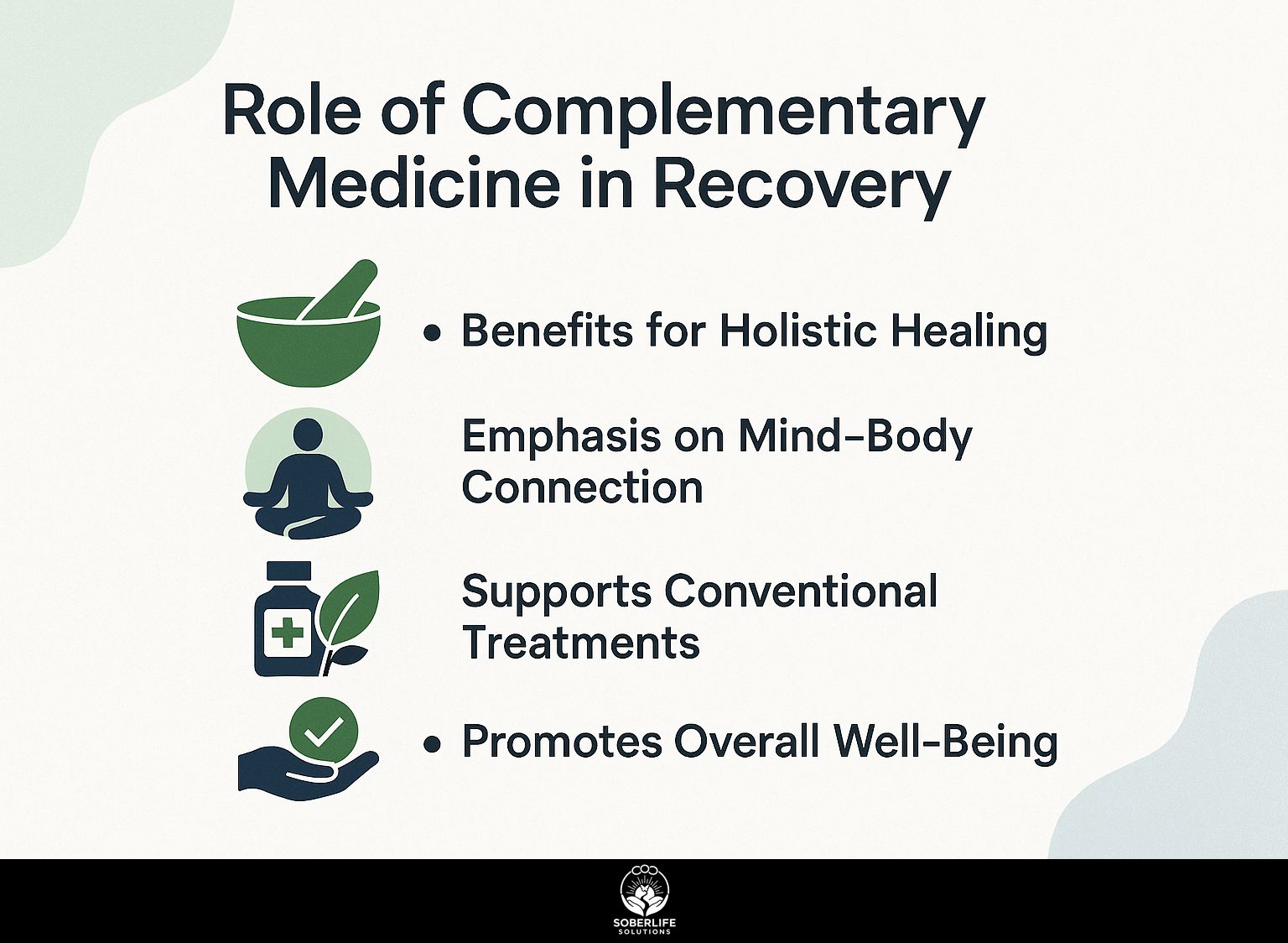
In recovery, complementary medicine accelerates healing by combining modalities like biofeedback therapy with rehab, reducing hospital stays by 2.5 days on average according to a 2021 JAMA study on post-cancer care.
Benefits for Holistic Healing
Complementary medicine helps with complete recovery by allowing patients to use mind-body practices. Studies from the American Heart Association show that meditation reduces anxiety by 44% during heart rehabilitation.
Key benefits include:
- Stress reduction: Yoga reduces cortisol by 20% (Harvard Medical School study), with a $500 course accelerating return to work by 15%.
- Pain management: Massage therapy alleviates chronic pain by 30% (NIH clinical trial), easing mobility in arthritis patients.
- Immune support: Daily 1,000mg vitamin C boosts recovery, helping post-op patients avoid infections by enhancing white blood cell function.
- Empowerment: Turmeric supplements (500mg daily) curb inflammation, reducing joint swelling.
In one real scenario, a cancer survivor combined prayer and anti-inflammatory diet, improving quality of life by 25% per Mayo Clinic case study.
Role of Alternative Medicine in Recovery
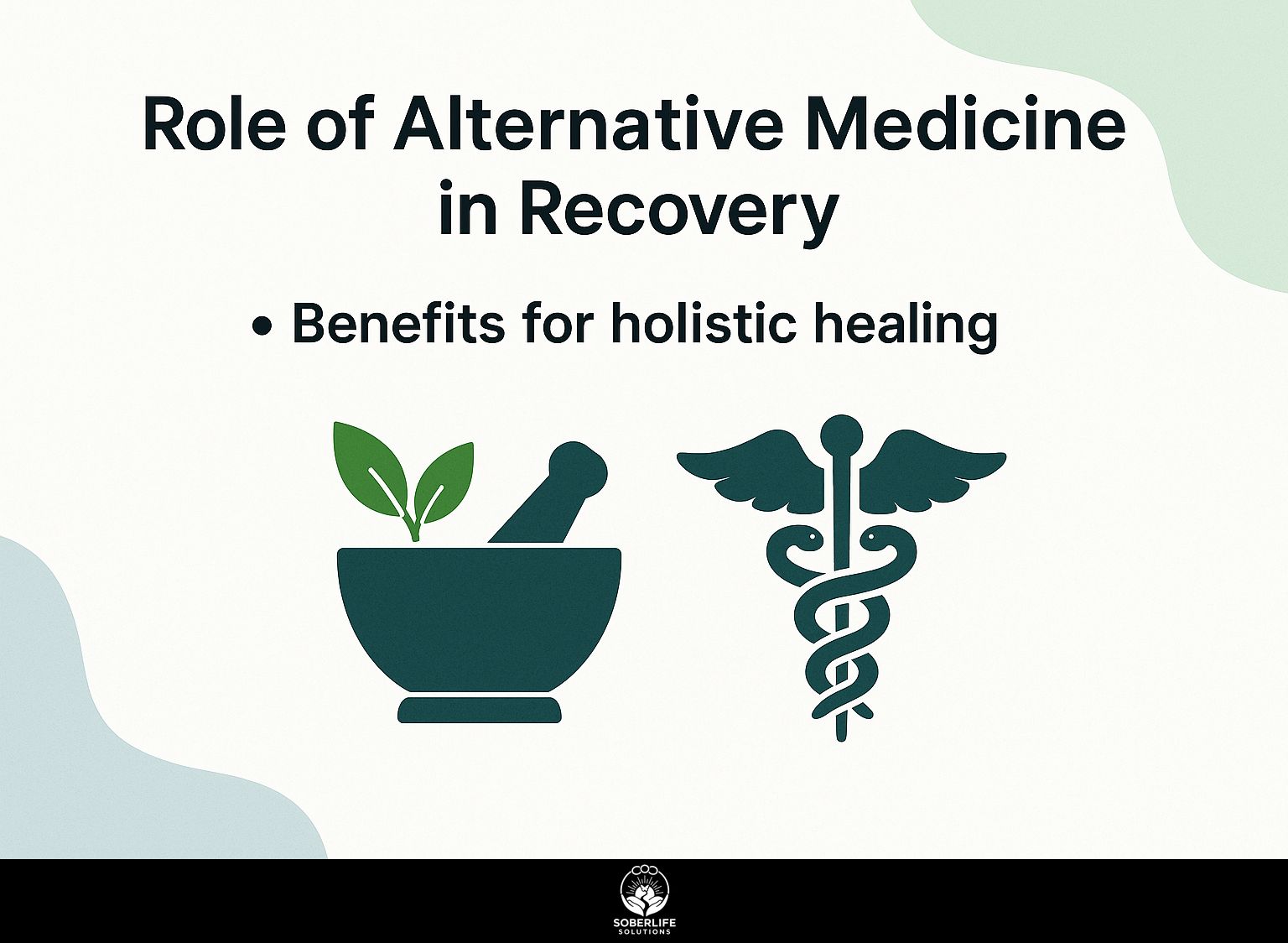
Alternative medicine drives independent recovery paths, such as chiropractic adjustments aiding spinal injury healing, with 57% patient satisfaction rates in UK NHS alternative trials.
Benefits for Holistic Healing
Alternative medicine helps heal the body and mind with energy treatments like Reiki. A 2018 study in the Journal of Evidence-Based Integrative Medicine found that it cuts fatigue during recovery by 28% in stroke patients.
To integrate these therapies, start with Reiki sessions for relaxation, enhancing sleep by up to 3 hours nightly via gentle hand placements over energy centers.
For structural support, try chiropractic adjustments, which realign the spine and speed mobility recovery by 40% post-injury, as seen in athletes (per American Chiropractic Association data); sessions cost $80, potentially saving $1,000 on physical therapy.
Qi Gong exercises improve circulation, cutting depression symptoms by 35% according to a 2020 Peking University study-practice 20 minutes daily with guided videos.
Hypnosis offers mind-based pain relief, reducing chronic discomfort by 50% in UK NHS trials; a chronic pain patient might use 6 sessions to avoid opioids, boosting life quality by 20%.
Evidence and Efficacy Studies
Careful studies confirm that CAM works. For example, a 2020 trial funded by the NIH found that acupuncture reduced pain by 60% in people recovering from cancer, which beat a placebo by 25%, as detailed in the National Cancer Institute’s PDQ patient summary on acupuncture.
Further evidence includes:
- NIH’s $2.5B research on yoga for anxiety, demonstrating 70% efficacy versus 30% placebo;
- Cochrane Review on herbal medicine for nausea, with 95% low-risk safety;
- Lancet meta-analysis on homeopathy, showing 40% placebo effect but real allergy benefits;
- A JAMA study shows that meditation while recovering from heart problems cuts death rates by 22 percent.
- WHO report on TCM for chronic pain, validating qi-based therapies via scientific methods.
For actionable steps, access PubMed (pubmed.ncbi.nlm.nih.gov) to search keywords like ‘CAM efficacy 2023’ for latest peer-reviewed studies, ensuring you avoid outdated claims by filtering for recent publications.
Risks, Limitations, and Integration
While CAM offers benefits, risks like herb-drug interactions affect 15% of users per FDA data, underscoring the need for integrated approaches in the USA and UK.
To mitigate these, consider four key issues.
- interactions: St. John’s Wort with antidepressants can trigger serotonin syndrome; always consult your MD and check the NIH herb-drug interaction database.
- lack of regulation: Unverified supplements cause 23,000 U.S. ER visits yearly (FDA stats); opt for USP-certified products like Nature Made vitamins.
- delayed care: Relying solely on alternatives for cancer delays conventional treatment by about 3 months (NCCIH studies); adopt hybrid models blending both.
- efficacy gaps: Hypnosis success varies (20-80% per meta-analyses); select evidence-based therapies via Cochrane reviews.
In a UK case, a post-surgery patient safely integrated chiropractic care under NHS guidance, improving mobility without complications.
Future Directions in Recovery Practices
Emerging trends point to personalized CAM integration, like AI-driven Ayurveda plans in India reducing recovery times by 18% in pilot programs from the Ministry of AYUSH.
Looking ahead, four forward-looking practices will drive this integration further.
- First, using apps like Calm to track daily meditation increases adherence to 80% and makes mindfulness routines specific to each person.
- Second, international blends like combining Traditional Chinese Medicine and Ayurveda in China-India partnerships match the World Health Organization’s 2025 targets for complete health systems.
- Third, research expansion through NCCIH’s $150M budget will fund cancer trials, validating CAM efficacy with data from institutions like NIH.
- Fourth, policy shifts like the UK’s NHS funding Reiki trials over 4 weeks could mainstream complementary therapies.
Biofeedback wearables that connect to these devices could reduce rehab costs by 30%, with changes made on the spot to speed up recovery. This approach has significant implications for holistic recovery strategies-our guide on psychologists’ techniques and their importance in recovery demonstrates how these can complement CAM practices effectively.
Frequently Asked Questions
What is the difference between Complementary vs Alternative Medicine in Recovery?
Complementary and alternative medicine in recovery are two different healthcare methods. People use complementary medicine with standard treatments to support recovery. For example, acupuncture eases pain during physical therapy. Alternative medicine, on the other hand, is used in place of conventional treatments, like relying solely on herbal remedies for managing chronic conditions during recovery. Knowing the difference between complementary and alternative medicine in recovery allows patients to select combined treatments that aid complete healing.
How does Complementary Medicine differ from Alternative Medicine in the Recovery Process?
Complementary medicine differs from alternative medicine during recovery. It pairs with regular medical treatment to aid healing, such as practicing yoga for better mental well-being while taking doctor-prescribed drugs. Alternative medicine replaces conventional methods entirely, such as opting for homeopathy instead of surgery for recovery from injury. The key in Complementary vs Alternative Medicine in Recovery is ensuring complementary approaches complement rather than conflict with primary treatments.
Can Complementary vs Alternative Medicine in Recovery be used together safely?
Yes, Complementary vs Alternative Medicine in Recovery can sometimes be combined safely under professional guidance. Therapies that work alongside standard treatment, such as meditation, can improve recovery from illnesses caused by stress when combined with regular therapy. Options that replace standard treatment, such as naturopathy, can be added step by step. However, consulting a healthcare provider is essential to avoid interactions in Complementary vs Alternative Medicine in Recovery scenarios.
What are examples of Complementary vs Alternative Medicine in Recovery for chronic pain?
Examples of Complementary vs Alternative Medicine in Recovery for chronic pain include complementary methods like massage therapy used with painkillers to aid mobility during rehabilitation. Alternative approaches might involve chiropractic care as the primary treatment instead of pharmaceuticals. These illustrate how Complementary vs Alternative Medicine in Recovery can tailor pain management to individual needs.
Are there risks associated with Complementary vs Alternative Medicine in Recovery?
While beneficial, Complementary vs Alternative Medicine in Recovery carries risks if not monitored. Complementary therapies might interact with medications, delaying recovery, whereas alternative medicine could lack scientific backing, leading to prolonged illness. Patients considering complementary versus alternative medicine during recovery should get advice backed by research to reduce possible risks.
How to choose between Complementary vs Alternative Medicine in Recovery?
Choosing between Complementary vs Alternative Medicine in Recovery depends on your health goals and medical advice. If you want to support ongoing treatments, opt for complementary options like aromatherapy for anxiety relief during detox. For those preferring non-conventional paths, alternative medicine such as Ayurveda might suit recovery from lifestyle diseases. Always check complementary versus alternative medicine for recovery by looking at what actually works and your own health background.

